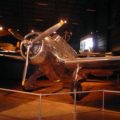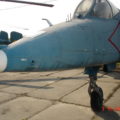
Doak VZ-4 | |
|---|---|
| Land | Norge , Norge |
| Rolle | VTOL forskning konvertiplane |
| Første flytur | 25 February 1958 |
| Bygget | 1 |
Den Doak VZ-4 (or Doak Model 16) was an American prototype Vertical Takeoff and Landing (VTOL) aircraft built in the 1950s for service in the United States Army. Only a single prototype was built, and the U.S. Army withdrew it from active trials in 1963.
Kilde: Doak VZ-4 på Wikipedia
| Doak 16 VZ-4DA Walk Around | |
|---|---|
| Photographer | Vladimir Yakubov |
| Localisation | US Army Transportation Museum, Fort Eustis |
| Photos | 39 |
Les også:
Den Doak VZ-4 was an experimental aircraft developed by the Doak Aircraft Company in the 1950s for the U.S. Army. It was designed to demonstrate the feasibility of a vertical take-off and landing (VTOL) aircraft that could transition to horizontal flight. The VZ-4 used a ducted fan propulsion system, in which two large fans were mounted on the wingtips and could be tilted vertically or horizontally. The fans were driven by a single turboprop engine located in the fuselage. The VZ-4 had a conventional tail and a tricycle landing gear. The pilot sat in a bubble canopy that provided good visibility.
The VZ-4 made its first flight in 1958 and performed several successful transitions between vertical and horizontal flight modes. The aircraft was capable of hovering, flying backwards, and sideways. It had a maximum speed of 200 mph and a range of 400 miles. The VZ-4 was evaluated by the U.S. Army and the U.S. Air Force, but neither service showed interest in procuring the aircraft. The VZ-4 was retired in 1960 and donated to the Smithsonian Institution, where it is currently on display at the Steven F. Udvar-Hazy Center.
Views : 2051











